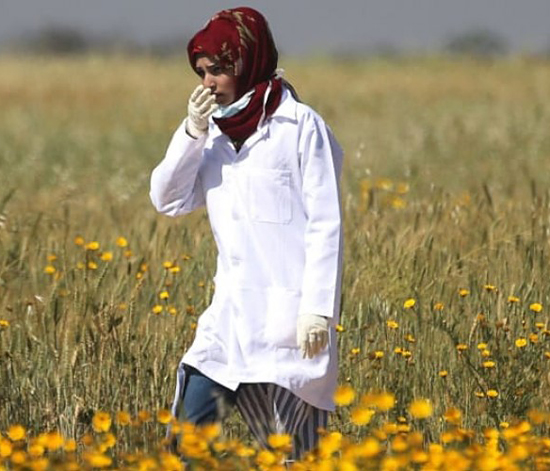
Razan al-Najjar working at the Gaza Strip border, April 1, 2018. “What’s the name of the soldier who killed her, with direct fire to the chest? We don’t know, and we probably won’t ever know.” (Photo: Ibraheem Abu Mustafa/Reuters)
We know her name: Razan al-Najjar. But what’s his? What’s the name of the soldier who killed her, with direct fire to the chest last Friday? We don’t know, and we probably won’t ever know.
In contrast to the Palestinians suspected of killing Israelis, the Israeli who killed Najjar is protected from exposure to the cameras and an in-depth breakdown of his family history, including his relatives’ participation in routine attacks on Palestinians as part of their military service or their political affiliation.
Demanding Israeli microphones will not be pushed into his face with probing questions: Didn’t you see she was wearing a paramedic’s white robe when you aimed at her chest?
Didn’t you see her hair covered with a head scarf? Do your rules of engagement require you to shoot at paramedics, men and women as well, and at a distance of about 100 meters (some 330 feet) from the border fence? Did you shoot at her legs (why?) and miss because you’re useless? Are you sorry? Do you sleep well at night? Did you tell your girlfriend it was you who killed a young woman the same age as her? Was Najjar your first?
The anonymity of our soldiers picking off and killing Palestinians is an inseparable part of the culture of Israeli impunity. We are above it all. Immune from everything. Allowing an anonymous soldier to kill a young paramedic with a bullet that hit her in the chest, exiting from her back, and continuing on with our lives.
There are lots of pictures of Najjar on the internet: She stood out as one of the few women among the first aid teams operating at the “March of Return” protest sites since March 30.
After two years’ training, she volunteered for the Palestinian Medical Relief Society. She happily gave interviews, including to The New York Times’ correspondent in Gaza, speaking about the ability of women to act under difficult conditions no less so than men – and even better than them. She knew how dangerous her job was. A paramedic was killed by Israel Defense Forces fire on May 14, dozens of others were injured and suffocated as they ran to rescue the wounded.
Najjar, 21 at the time of her death, was from the village of Khuza’a, east of Khan Yunis. In interviews, she was not asked about the wars and Israeli military attacks during her childhood and later. It is hard to find their scars in her pleasant face seen on screen. In every interview, she is seen wrapped in a head scarf of a different color – and each time it is wrapped around her head stylishly, meticulously, showing an investment of time and thought. The color reveals a love for life, despite all she had gone through.
We do not know the name of the soldier, but we do know who is in the chain of command that ordered and enabled him to kill a 21-year-old paramedic: Southern Command chief Maj. Gen. Eyal Zamir. IDF Chief of Staff Lt. Gen. Gadi Eisenkot. Military Advocate General Brig. Gen. Sharon Afek and Attorney General Avichai Mendelblit, both of whom approved the wording of the rules of engagement, as the High Court justices were told before they denied petitions against the shooting at protesters along the border fence.
Despite all the testimony about civilian fatalities and horrifying injuries, the justices chose to believe what they were told in the name of the military by Avi Milikovsky, a lawyer from the State Prosecutor’s Office: The use of potentially lethal force is taken only as a last resort, in a proportionate manner and to the minimal extent required.
Please explain how this tallies with the death of Najjar, who was treating a man injured directly by a tear-gas canister. An eyewitness told The New York Times that while the injured man was being taken to an ambulance, her colleagues were treating her because she was suffering the effects of the tear gas. Then shots were heard and Najjar fell.
High Court Justices Esther Hayut, Hanan Melcer and Neal Hendel presented the army with an exemption from investigation and an exemption from criticism on a silver platter. In doing so, they joined the chain of command that ordered our anonymous soldier to fire at the chest of the paramedic and kill her.
Amira Hass is the Haaretz correspondent for the Occupied Territories. Born in Jerusalem in 1956, Hass joined Haaretz in 1989, and has been in her current position since 1993. As the correspondent for the territories, she spent three years living in Gaza, which served of the basis for her widely acclaimed book, Drinking the Sea at Gaza. She has lived in the West Bank city of Ramallah since 1997. Hass is also the author of two other books, both of which are compilations of her articles. Reprinted from Haaretz with permission.


